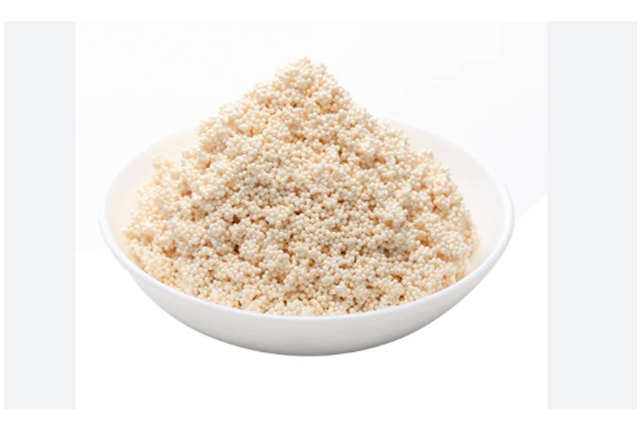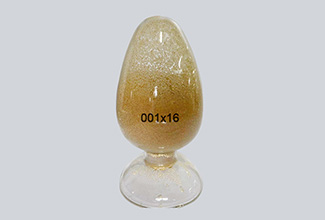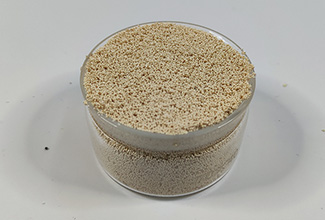What Is The Russian Strength Of Uranium Extraction Resin?
1.Mechanical Stability Is Crucial In Uranium Extraction.
Uranium extraction resins are core components of ion exchange systems, playing a crucial role in selectively adsorbing uranium ions from solution, directly impacting the overall efficiency and purity of uranium extraction. Resin performance is equally important for chemical properties (such as ion exchange capacity and selectivity) and mechanical properties, which together determine the resin's effectiveness in actual operating conditions. "Russian strength," a key mechanical performance metric, measures the resin's durability during operation and directly impacts its long-term stability. This article aims to clearly explain the meaning of "Russian strength" and its specific impact on uranium extraction performance, providing a professional reference for practitioners.
2.What is Russian strength ?
"Russian strength" is a metric used to assess the mechanical integrity of resin particles. The concept originated from a resin evaluation system in Russia (or the former Soviet Union) and was originally proposed to meet the stringent requirements for high-performance resins in the nuclear industry. This metric focuses on the resin particle's ability to resist breakage under mechanical stress. It differs significantly from commonly used Western metrics such as attrition loss or osmotic shock resistance. Attrition loss primarily measures the degree of wear on the resin surface due to friction, while osmotic shock resistance focuses on the stability of the resin's internal structure under sudden concentration fluctuations. Russian strength, on the other hand, more directly reflects the resin particle's overall resistance to breakage. Even today, Russian strength remains a crucial evaluation metric for nuclear-grade ion exchange resins, thanks to its precise matching of the high mechanical performance requirements of resins in nuclear industry applications like uranium extraction, providing a key basis for resin quality control.
3.Russian Strength Testing Method
The Russian strength test adheres to Russian standards. Its core principle is to apply mechanical stress to the resin through vibration or tumbling, simulating the external forces the resin may encounter in actual operation, thereby assessing its mechanical stability. The specific testing steps are as follows: First, a certain amount of dry resin is selected as a sample to ensure representativeness. Second, the sample is placed in a specific device and mechanically agitated according to a standard time and speed to ensure uniform and stable mechanical stress on the resin. Finally, after the test, the number of intact resin particles is counted and the percentage of the total sample volume is calculated. This percentage is the resin's Russian strength value.
In actual applications, the Russian strength values of different resin types typically fall within a range: Industrial-grade resins typically have a Russian strength value of 90%-92%; nuclear-grade resins, due to their higher mechanical performance requirements, typically have a Russian strength value of 95%-98%; and high-performance uranium extraction resins must achieve a Russian strength value of ≥98% to meet long-term stable operation requirements. When interpreting these values, it is helpful to compare them to the standard range for similar resins to determine whether the resin's mechanical properties meet the standards. Higher values indicate greater mechanical integrity and durability.
4.Why Is High Mechanical Strength Crucial For Uranium Absorb Resins?
During uranium extraction, resins endure multiple harsh conditions: intense hydraulic flow subjects resin particles to continuous impact and friction; chemical regeneration involves frequent exposure to acids and alkalis, potentially causing particle expansion or contraction; and acidic environments in certain operating conditions further accelerate resin degradation. These processes simultaneously subject the resin to mechanical stress and chemical attack. If the resin lacks sufficient mechanical strength, it becomes highly susceptible to breakage and wear.
High mechanical strength indicates that the resin possesses excellent mechanical stability. It can maintain its physical structure integrity under these complex operating conditions, preventing a reduction or failure of ion exchange sites due to particle breakage. This ensures the resin consistently maintains good functional activity. Resin integrity directly correlates with uranium recovery efficiency: intact resin particles possess sufficient effective adsorption surface area to efficiently exchange with uranium ions. Conversely, fragmented resin not only reduces adsorption capacity but may also clog equipment piping, severely impacting the smoothness of the uranium extraction process and ultimately the recovery rate.
5.Key Process Parameters Affected by Russian Strength
(1) Hydraulic Performance and Pressure Drop
When resin Russian strength is low, hydraulic forces readily cause particle breakage. These fragmented particles fill the pores within the resin bed, reducing bed porosity and significantly increasing flow resistance through the bed. This change directly impacts system pressure drop (ΔP), causing it to rise. Simultaneously, it disrupts flow uniformity, leading to velocity fluctuations that impair sufficient contact between uranium ions and resin, thereby reducing adsorption efficiency.
(2) Uranium Adsorption Efficiency
Resin integrity is fundamental to ensuring uranium adsorption efficiency. Intact resin particles possess regular morphology and ample specific surface area, providing more exchange sites for uranium ions while facilitating ion diffusion within the particles, thereby enhancing ion exchange kinetics. If resin fragments due to insufficient mechanical strength, it not only reduces the effective adsorption area but also risks forming localized accumulations of broken particles within the bed. This leads to channeling (where flow prioritizes paths of least resistance) and dead zones (areas of stagnant flow), preventing adequate uranium-ion contact with the resin. Consequently, adsorption becomes incomplete, significantly reducing uranium adsorption efficiency.
(3) Resin Loss Rate and Service Life
During backwashing and regeneration in uranium extraction, the resin undergoes repeated expansion, contraction, and mechanical agitation. Resins with low mechanical strength are prone to particle breakage and wear during these operations, leading to increased resin loss rates. As operational cycles accumulate, the total resin volume continuously decreases. When resin levels fall below a certain threshold, replacement with new resin becomes necessary. This not only increases resin consumption costs but also causes production interruptions due to resin replacement, shortening the actual service life of the resin.
(4) Elution and Regeneration Performance
The stability of a resin's pore structure is critical for mass transfer efficiency during elution and regeneration. Resins with high mechanical strength maintain stable pore structures during these processes, allowing eluents and regenerants to fully penetrate the resin particles and react with adsorbed uranium ions, ensuring effective elution and regeneration. Conversely, resins with poor mechanical strength are prone to pore structure damage under the combined effects of chemical reactions and mechanical agitation during elution and regeneration. This impedes mass transfer, leading to uneven regeneration. Such issues not only reduce resin regeneration efficiency but also increase consumption of eluents and regenerants, thereby raising operational costs.
(5) Effluent Clarity and Secondary Pollution
Resins with low mechanical strength generate fine resin particles (resin dust) during operation. Due to their small size and light weight, these dust particles are difficult to effectively retain and can easily be discharged with the effluent, increasing effluent turbidity and compromising effluent clarity. During uranium extraction, this resin dust may adsorb radioactive uranium ions. If discharged with the effluent, it can cause radioactive solid contamination, posing safety hazards to the environment and subsequent treatment processes.
(6) System Reliability and Operational Economics
Particles generated from resin breakage can clog equipment components such as filter screens and pipelines, causing frequent system failures. This increases maintenance frequency and difficulty, prolongs downtime, and severely compromises system reliability. From an economic perspective, frequent maintenance incurs high costs, while repeated resin replacements increase procurement expenses. Additionally, downtime leads to production losses. High-strength resins mitigate these issues, reduce total cost of ownership, ensure continuous and stable system operation, and enhance overall operational efficiency.
6. Comparison With Other Strength Indicators
|
Metric |
Test Type |
Measurement Content |
Typical Application Scenarios |
|
Russian Strength |
Mechanical Vibration |
Resistance of resin beads to crushing |
Uranium extraction resin, nuclear-grade resin |
|
Wear Rate |
Air or Water Agitation |
Degree of surface wear on resin |
Conventional water treatment resin |
|
Osmotic Shock Resistance |
Rapid Concentration Change |
Stability of internal resin structure |
High-purity preparation resin, nuclear-grade resin |
In practical applications of uranium extraction columns, the primary challenge facing resin particles is mechanical vibration and impact-induced fragmentation, rather than simple surface wear or internal structural damage caused by sudden concentration changes. Russian strength directly evaluates resin particle fracture resistance by simulating mechanical stresses encountered during actual operation. Its test results correlate more closely with the resin's real-world durability in uranium extraction columns, providing a more accurate reflection of resin performance in this scenario. Consequently, it holds greater reference value compared to other strength metrics.
7.Typical Values and Quality Standards for Uranium Extraction Resins
High-performance uranium extraction resins typically require elevated Russian Strength levels. Nuclear-grade uranium extraction resins, as industry benchmark products, mandate Russian Strength of no less than 95% (i.e., ≥95% intact particles), with some premium products achieving over 98%. Within the uranium extraction resin quality control system, Russian strength is not the sole evaluation metric. It forms part of a critical quality assessment framework alongside indicators such as moisture content, exchange capacity, and uniformity coefficient. Moisture content influences the resin's physical state and ion exchange activity; exchange capacity determines the resin's adsorption capacity for uranium ions; and the uniformity coefficient reflects the consistency of resin particle size, affecting the hydraulic performance of the bed. These indicators are interrelated and mutually influential. Only when all meet standard requirements can the resin deliver outstanding performance during uranium extraction.
8.Practical Advantages of High Russian Strength
Uranium extraction resin with high Russian strength offers multiple practical benefits: First, it extends resin lifespan. Its superior fracture resistance allows for more regeneration cycles, reducing replacement frequency. Second, it reduces operational pressure and energy consumption. A complete resin bed maintains high porosity and low hydraulic resistance, enabling stable flow rates without additional pressure, thereby lowering energy use. Third, it enhances the stability of uranium adsorption and elution performance. The stable resin structure consistently maintains strong ion exchange capacity, ensuring minimal fluctuations in adsorption and elution efficiency. Fourth, it reduces resin replacement costs and downtime, lowers maintenance workload, and boosts production efficiency; Fifth, in radioactive operating environments, it minimizes resin dust generation, reduces radioactive contamination risks, improves effluent clarity, and safeguards operational and environmental safety.
9.Conclusion
In summary, Russian Strength serves as a critical metric for evaluating the mechanical durability and process reliability of uranium extraction resins. Resins with high Russian strength maintain structural integrity and functional stability under demanding uranium extraction conditions, forming a vital foundation for safe, efficient, and economical uranium extraction operations. Therefore, when selecting uranium extraction resins, it is recommended to prioritize products tested and certified for high Russian strength to ensure long-term stable operation of uranium extraction plants, achieving a balance between economic and safety benefits.
-
 Gold Extraction Resin Metal Removal and RecoveryAppearance: White to light yellow opaque beadsIonic form:CLVolum exchange rate (mmol/ml):0.30~0.70
Gold Extraction Resin Metal Removal and RecoveryAppearance: White to light yellow opaque beadsIonic form:CLVolum exchange rate (mmol/ml):0.30~0.70 -
 001x16 Strong Acid Cation Exchange ResinAppearance: Claybank to tan transparent spherical particle.The degree of crosslinking : 16%.Ionic form:Na+
001x16 Strong Acid Cation Exchange ResinAppearance: Claybank to tan transparent spherical particle.The degree of crosslinking : 16%.Ionic form:Na+ -
 Chelating Resin for Precious Metals RecoveryAppearance: Milky to light yellow opacity spherical beadsIonic form:Na+Volume complete exchange capacity(mmol/ml):≥2.0
Chelating Resin for Precious Metals RecoveryAppearance: Milky to light yellow opacity spherical beadsIonic form:Na+Volume complete exchange capacity(mmol/ml):≥2.0

